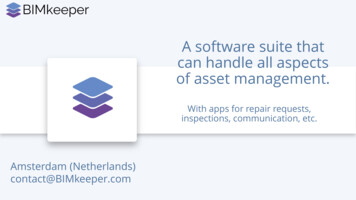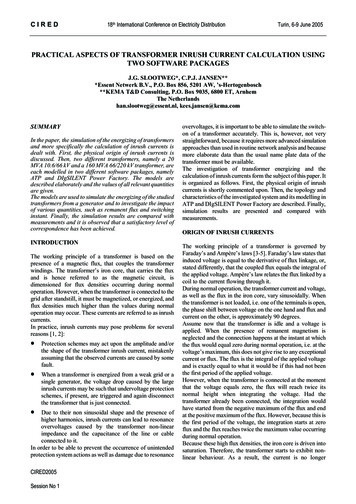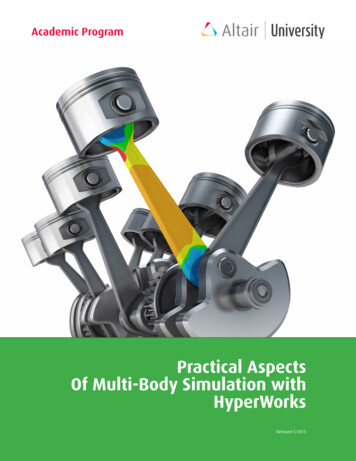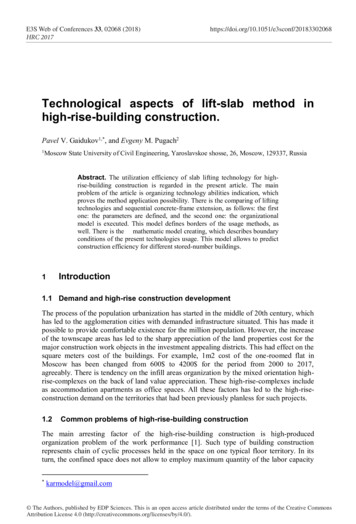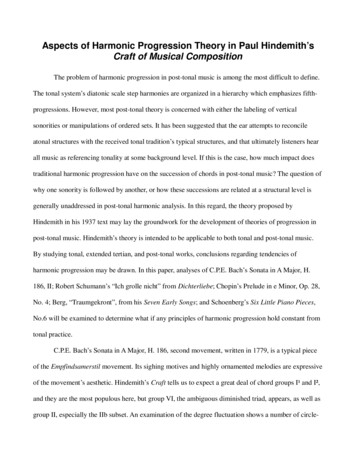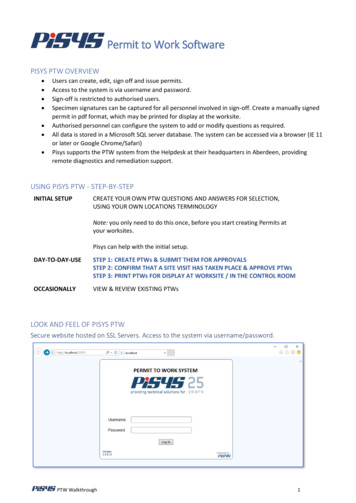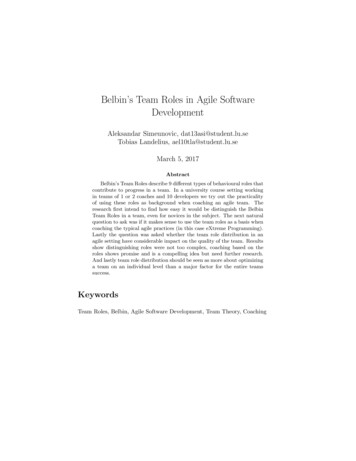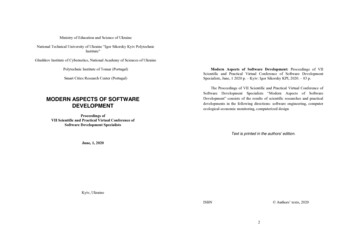
Transcription
Ministry of Education and Science of UkraineNational Technical University of Ukraine "Igor Sikorsky Kyiv PolytechnicInstitute"Glushkov Institute of Cybernetics, National Academy of Sciences of UkrainePolytechnic Institute of Tomar (Portugal)Smart Cities Research Center (Portugal)MODERN ASPECTS OF SOFTWAREDEVELOPMENTModern Aspects of Software Development: Proceedings of VIIScientific and Practical Virtual Conference of Software DevelopmentSpecialists, June, 1 2020 р. – Kyiv: Igor Sikorsky KPI, 2020. – 83 p.The Proceedings of VII Scientific and Practical Virtual Conference ofSoftware Development Specialists “Modern Aspects of SoftwareDevelopment” consists of the results of scientific researches and practicaldevelopments in the following directions: software engineering, computerecological-economic monitoring, computerized designProceedings ofVII Scientific and Practical Virtual Conference ofSoftware Development SpecialistsText is printed in the authors’ edition.June, 1, 2020Kyiv, UkraineISBN Authors’ texts, 20202
CONTENTSBochok V. Construction of data collection and analyticssystems for IT vacancies .5Shaldenko O., Hulak O. Analysis of monitoring methods andidentification of illegal outdoor advertising . 62Gaidarzhy V., Huchenko M. Web-system for centralizedmanagement of distribution educational literature . 9Sydorenko IU., Kryvda O.V., Horodetskyi M. Processing oflarge arrays of data by Gaus interpolation methods 66Gruts YU., Holotiuk P. Implementation of procedures forbuilding wire-frame stereoscopic images with multi-angleobservation . 13Tytenko S., Omelchenko P. Concept maps in the individuallearning environment . 71Husyeva I. Mobile sensors in intelligent transportationsystems 17Karaieva N., Varava I. Methodology design of monitoringsystem of indicators of the human development level ofUkraine's regions 22Tytenko S., Talakh O., Zinkevych B. Automated constructionof test tasks based on decomposition of educational text . 75Yerokhina A. Comparison of binary methods of multi-labelclassification Kublii L., Horodetskyi M. The use of images forsteganographic information protection . 27Kublii L., Mykhal’ko V. Software tools for intellectual andstatistical processing of hydroacoustic signals . 31Kuzmіnykh V., Kotsubanov G. The decision-support platformfor international scientific and technical cooperation . 35Kuzminykh V., Polishchuk K. Interpreter of advanced databasemanagement commands .38Kuzminykh V., Taranenko R. Expert system for assessing thequality of information . 41Kuzminykh V. Tymoshenko M. Automation of assessment andforecasting of development of higher educational institutions. 45Mykhailova I., Tyschenko A. Web registry of electronicinformation resources . 48Segeda I. Cloud data storage services 52Shushura O., Havrylko Y. Conceptual modeling of fuzzycontrol . 583478
Bochok V.CONSTRUCTION OF DATA COLLECTION ANDANALYTICS SYSTEMS FOR IT VACANCIESModern information technology solves a very wide range ofproblems, and some of them did not exist even in the last decade. Forexample, in this decade, tasks such as distributed calculations of largeamounts of data, building systems that can handle heavy loads, blockchain,and machine learning come to the fore. New areas continue to emerge andbring new specialized technologies and approaches. But what unites them— they need software implementation that requires knowledge of certainalgorithms, principles, and tools. Due to the limited number of engineersand the areas of development that are often strongly related, it requires aspecialist to have extensive expertise in many areas.Business development leads to the evolution of problems that needto be solved. As a result, certain technologies and tools are becomingobsolete and less relevant. In their place come others. This transition takestime, so it is extremely important to be able to analyze trends and maketimely decisions in order to always be competitive in the labor market.Currently, there are services that provide information on therelevance of a limited number of technologies, mostly programminglanguages, as well as job search sites that provide some surface analysis ofcertain types of vacancies. The problem of the first type of services, such asthe TIOBE index, is the focus on one specific metric and a limited numberof technologies [1]. For example, TIOBE focuses on the number of searchqueries on the Internet. It is quite difficult for ordinary engineers to drawcertain conclusions from such ratings. For example, C is ranked first with arating of 17.7%, and Python is ranked third with a rating of 9.12%,however, there are far fewer vacancies related to the former.The drawback of analytics that provides job search sites is that, forthe most part, such resources work with a wide range of professions, each ofwhich requires certain skills. For such sites, it makes no sense to distinguishcertain technologies, such as programming languages, from other text,because for managers or designers they simply do not matter. Andvacancies on such resources are filtered using full-text search. Also, suchsites can use not the vacancies themselves as a source of information, butsurveys of engineers, which in some cases are not representative. A sampleof such surveys per year can only recruit 5,000 respondents. We should alsotake into account that engineers have no motivation to conduct surveys orprovide reliable information.To solve this problem, the subject area was analyzed and it was5decided to build a system based on vacancies as the most representativesource. The problem was that the sources of vacancies, although mostlyopen, were unstructured and contained different formats. Also, a vacancy isa textual description that contains a large amount of information in arandom order, which is extremely difficult for a computer to process. Inaddition, all data is in different sources and must be stored in its owndatabase in order to perform complex operations on them relatively quickly.The system is complex and consists of several services that worktogether. The advantage of this approach is the flexibility and ability tochange some modules without changing other services, except in situationswhere the service interface is changing. It also gives an ability to scale thesystem to respond to heavy loads. For this aim was also implementedoAuth2 authentication, which will reduce a number of queries to thedatabase.We should also cover a problem of communication for multipleparts of application and easy way to manage the infrastructure to deploysoftware.During the modeling process was decided to develop a system,consisting of 3 services and code, which is made in a separate module, butpossible to because a separate service in the future to make the code a littlebit slower but more flexible.Figure 1 — The structure of interaction of system servicesParsers run every day and process all vacancies currently available.Usually, resources are provided only by vacancies that were active no morethan a month ago. Each parser must provide the following data:6
1. id external — a string containing a unique identifier from thesystem from which the vacancy was taken. Required field.2. data source — string identifies the unique name of the servicesource of vacancies. Required field.3. url — path to the vacancy.4. title raw — vacancy title in raw form.5. publication date — vacancy publication date (often unavailablefield).6. date parsed — the date when the vacancy was parsed.7. required technologies raw — the text of the vacancy (or a certainpartof it, which contains information about the technologies that theworker needs to know. It is often very problematic to select the necessarypart of the text, so the entire description of the vacancy is saved foranalysis).The next step will be to correct the so-called data extractors. Thenext step is data transformation covered by data extractors. Their behavioris controlled by the configuration, provided in JSON format. Extractors areused to extract technologies and vacancy levels. They are built to solvemost of the collisions that are possible to paper in the text. The full list offields added by extractors are listed below:1. required technologies – extracted from vacancy text.2. vacancy level – extracted from vacancy title.3. core technologies – extracted from vacancy title.All collected vacancies are stored in the unverified vacanciescollection in MongoDB. This solution allows for some analysis oraggregation of the data. For example, you can add functionality that allowsyou to view vacancies and correct information manually. It will also allowyou to adjust system configurations. The data extractor requires rulesencoded in JSON that it can obtain from the server part.To create a server that will be able to communicate and control allthe others was decided to build the unified RESTful API. One of thepriorities was to achieve a flexible system with minimum time spent. That iswhy was used a framework with a great variety of ready-to-use extensions.The Flask was used because of the minimum functionality out of the boxwith the ability to the extent. The application architecture uses FlaskRestplus [2, 3].To create a server that will be able to communicate and control allthe others was decided to build the unified RESTful API. One of thepriorities was to achieve a flexible system with minimum time spent. That iswhy was used a framework with a great variety of ready-to-use extensions.The Flask was used because of the minimum functionality out of the boxwith the ability to the extent. The application architecture uses Flask7Restplus [2, 3] which provides an advanced way to document the app withSwagger and validate user input with Marshmellow. To control the versionsof the database was decided to use a Flask-Migrate plugin. SQLAlchemyand PyMongo integrations were added to communicate with the databases.MongoDB is NoSQL database, which requires a denormalizationprocess performing on data. It's really fast for reading/writing operationsand able to store a schema-free data. On the other hand, the engineer needsto control data consistency. For example, if the administrator changes thename of the technology, you need to change this name in all vacancies thatare linked to this technology.There was decided to use both SQL and NoSQL databases to getthe best from them. SQLite stores all relational data except the vacancies tocontrol the data consistency and MongoDB is performing complex datafiltering and aggregating steps. It's also able to handle a great amount ofdata and scale horizontally by just adding additional nodes with masterslave replication. It's also good for logging or metrics that can be collectedin the future.The interface was implemented using the React framework. It aimsto build interfaces on the principle of single responsibility. The applicationfollows the principles of SPA (single page applications), which means thatthe application does not have to be rebooted to display new content. Even ifit's a new page. However, the link navigation history must be stored by thebrowser. This approach significantly speeds up the site, because you do notneed to download from the HTML server, styles, and libraries for each newrequest, but only the data that needs to be displayed. It also makes theapplication much more interactive.The last step is to configure the services to work one with another.With the docker-compose were described as infrastructure as code, whichmeans that all configurations that are required to be done on app starting arenow formalized in the YAML configuration file. All is needed to launch thewhole app is to perform a simple terminal command. An additionaladvantage is that all services will be wrapped in isolated containers and theonly way to interact with the app is sending requests to specified ports.References:1.TIOBE Programming Language Popularity Index [Electronicresource] - Resource access mode: https://www.tiobe.com/tiobe-index/.2.Flask Framework Documentation [Electronic resource] - Resourceaccess mode: https://flask.palletsprojects.com/en/1.1.x/.3. Fielding R. Architectural Styles and the Design of Networkbased Software Architectures: dis. Dr. comp. Science / Fielding Roy.8
Gaidarzhy V., Huchenko M.WEB-SYSTEM FOR CENTRALIZED MANAGEMENTOF DISTRIBUTION EDUCATIONAL LITERATUREThe amount of information and the speed which this data needs to beupdated is constantly growing to keep it up to date. Technological problemsof the educational process require the availability of an information systemfor storage and distribution of educational literature, which shouldcontribute to the improvement of the educational process.Most of the existing tools offer solutions [1] that require a lot of timeand resources to implement, which not every educational institution canafford. One of the goals was to create a system that automates the process ofsharing educational literature, making it easy to use and easy to implement.Practice shows that some educational institutions use online platforms forpublishing training courses or simply use cloud storages to solve some ofthe problems. In some cases, the use of cloud storage is implicit, while usee-mails.First of all, the developed system relieves the teacher ofresponsibility in the management of the distribution of educationalmaterials. The system undertakes to send students books, abstracts,laboratory works and other educational materials on the exact day and time.The system improves the quality and speed of students' mastery ofeducational materials, compared to traditional approaches.Paying attention to the fact that the institution of higher educationcan use non-standard solutions for data storage, the architecture of thedeveloped system takes this into account.The main focus is on improving the use of educational materials bystudents with a minimum cost of implementing the system. The main focusis on students studying on a full-time basis and need regular interaction withthe teacher.The following problems need to be addressed when developing anappropriate information system: lack of opportunity to plan in advance the date of distribution ofeducational materials, lack of automated tools for the teacher to form an array ofeducational literature (filling e-mails with identifiers, links to the topic ofthe curriculum), lack of control over the process of mastering educational literature, determining the direction of educational materials received by thestudent over time, lack of organizational principles for the preservation of educational9materials. It is important to consider a number of issues in more detail.The cost of implementationThe developed information system allows it to be easilyimplemented due to the fact that the student does not have to use thesystem, it is enough to have mail, which will receive all the necessaryinformation with content partially generated by the system and partly by theteacher.Lack of a unified approach to the design of e-mailsOver time, e-mails receive a large number of letters. Simply, when itcomes time to review materials that will be sent over several years, itbecomes very problematic. The reason for this is the lack ofsystematization.The developed information system uses a single structure for emails. This structure adds the following information to the letter:1. Subject2. Name of the material3. Title of the section related to study material4. The name of each topic related to study material5. Sender information,6. Additional information provided by the sender.All created emails saved into the system can be reused, just need topick one from the created (figure 1).Figure 1. Created emails pageThanks to the chosen structure, each student can arrange the lettersas he wishes and find the materials he needs. This is extremely importantbecause easy access to educational information is one of the highestpriorities.ArchitectureThe choice of software architecture is always one of the most10
important issues when creating an information system. Experience showsthat a well-designed architecture can save a lot of time and resources, whilea bad one can be fatal even for a project with a fascinating idea.Software architecture refers to making a set of strategic technicaldecisions related to a software product, documenting them and ensuringtheir implementation. Architecture design has become one of the mostimportant stages in building software, especially in the field of developmentof high-load systems.It was decided to use the “Monolith First” approach of building thearchitecture of the web-system for centralized management of distributioneducational literature. It allows to begin its development fairly quickly anddo not need to spend additional resources to support individual services.Microservice architecture is important for flexible development, buttheir use has a significant advantage only for more complex systems.Management of a set of services will significantly slow down thedevelopment, which indicates the advantage of using a monolith for simplersystems [3]. This leads to a strong argument of the strategy that it is worthstarting the development using a monolithic architectural style, even if theproject will later benefit from the architecture of microservices. In this case,the monolith should be designed carefully, paying attention to themodularity of the software, both at the boundaries of the API and datastorage. While maintaining the modularity within the monolith, thetransition to a microservice architecture is a relatively simple operation.Therefore, this approach, known as “Monolith First”, will allow youto use all the benefits of a monolithic architecture at the beginning of thesystem. The next advantage is when there is a requirement to use third-partytechnology for storage and processing of educational literature. In this case,the approach will allow you to quickly move from a monolith to amicroservice architecture.During development, a monolith with observance of modularity willbe created, which will allow to extract the module responsible forprocessing of educational literature without unnecessary efforts.DevelopmentEach of the software tools or approaches was involved based on aspecific architecture. Given that the architecture in the system clearlyseparates the server part from the client, both parts were consideredseparately.No less important is the protection of the web-system. In order forthe developed system to have good protection, a number of approaches andsoftware were used such as JSON Web Tokens or Spring Security.Testing is an integral part of the software development process.Moreover, one of the conditions of a certain architecture is test coverage,11because it helps to monitor the quality of written code. There were tests ofdifferent types, including:1. modular testing of the client and server part of the system2. integration testing of the server part of the system3. architectural testingAn information system uses several data storage solutions at once.Because learning resources must be stored separately from other data,different data warehouses have been involved and separate services havebeen developed to process the information before it reaches the repositoryitself.The already developed system was deployed on the Heroku cloudplatform.ConclusionsIn the course of the work, a system was created that automates theprocess of distribution of educational literature, making it easy to use andeasy to implement.The developed system relieves the teacher of responsibility inmanaging the distribution of educational materials. The system takes on thetask of sending students books, notes, laboratory work and other resourceson the exact day and time. The system improves the qualit
Software Development Specialists Text is June, 1, 2020 Kyiv, Ukraine 2 Modern Aspects of Software Development: Proceedings of VII Scientific and Practical Virtual Conference of Software Development Specialists, June, 1 2020 р.
